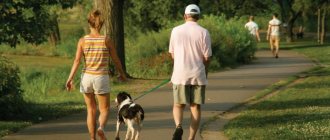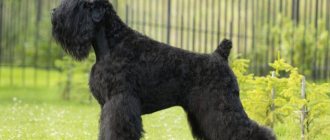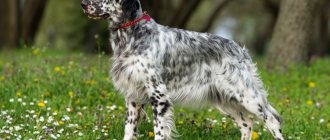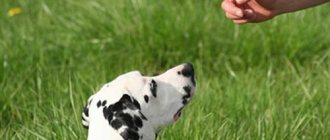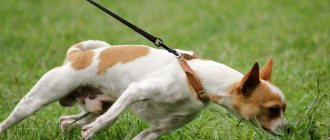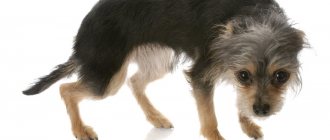January 27, 2016
What questions do people usually ask themselves when deciding to get a dog? Do I have enough money to support her? Do you have enough energy and time to walk and care for her? Is my apartment big enough for my dog to be comfortable in it? These are undoubtedly very important questions and they need to be answered. But for any city dweller, the main question is still different.
Where to go: size matters
“Where will I walk my dog to provide for its needs?” - this is the cornerstone on which the dream of finding a four-legged friend is often broken.
We have already written that a dog needs at least 1.5 hours of active walking a day. If you have at your disposal only a tiny patch of a yard filled with cars, half of which, if not all, is occupied by a children's playground, then you should still think about a cat, parrot or rodent. And you shouldn’t look for a compromise by studying sites describing dwarf breeds.
No matter how small a pet is, it remains a dog, which means it has exactly the same instincts and needs as representatives of large breeds. The only difference is the size of the territory that the dog needs for full walks.
You can walk a small dog on a special area - accordingly, make sure there is one near your house. For a medium or large dog, it is necessary to have a nearby park, large square or any other uncrowded “corner of nature”.
Make it a rule to never walk your dog, not only on the playground, but also in the yard! There are, of course, emergency situations, but then do not let your pet off the leash and be sure to clean up after him. If nothing urgent has happened, then for the well-being of your pet, the walk should be complete.
Teaching an adult dog to walk on a leash
No, we are not talking about the Near command, but about the calm behavior of the pet despite the restriction of freedom. It is not difficult to train your dog to walk on a leash; the main thing is to make it clear that the accessory is not dangerous. Use a long canvas leash or thin rope; the dog should be able to move far away from you without the “resistance” of the collar.
In the first stages, walk your dog in familiar territory and be sure to buy an address capsule or medallion with your contact information. Attach the leash to the collar, but do not hold it, let it drag along the ground. Periodically pick up the leash, but do not attach any importance to it; as soon as the pet becomes alert, return the “ugly rope” to the ground.
Note! The “training leash” tactic is recognized throughout the world. A long elastic rope is always and everywhere attached to the dog’s collar, which, if necessary, can be stepped on, limiting the dog’s movement.
At the next stage, it is not you who will walk your pet, but he who will walk you – in the literal sense. Follow your dog everywhere and do not be distracted, do not allow tension on the leash, the pet should feel free. Always show the leash when you call your pet for a walk, this will strengthen the positive conditioned reflex - the owner took this strange rope, which means we can run and play.
As soon as you notice that your pupil is wagging his tail when he sees the walking equipment, take the next step, namely, teach your pet not to pull on the leash. Get ready, it will take you at least a month to develop a reflex according to a loyal training scheme. So, you fastened the dog and went for a walk, the leash was pulled - you stood in place. Wait for the pet to turn its head, asking: “Well! We are going?". Show the pupil a tasty treat, call him over, praise him, distract him and continue walking, changing direction a little.
For every turn of the head, when the pet walks correctly, the dog should receive approval and hear: “Good!” If your pet has pulled on the leash and basically won’t turn around, wait silently, imagine that you are playing “reverse staring contest” and you are bound to win. The ward, at any cost, must understand that on a leash he goes where he is allowed, while the “hated rope” should not become taut.
Rules for a full walk
Develop several routes and note the time each of them takes - this will greatly help you in planning your day. In the morning time pressure, you can limit yourself to a short route - 15-20 minutes, in the evening use a long route - at least an hour, and just in case, keep in mind some middle option - 40 minutes.
A full walk includes free movement of the dog without a leash, which should occupy at least 60% of the allotted time. Otherwise, you simply will not be able to provide your dog with the necessary physical activity, namely running.
The maximum speed that a dog of proportional build and height of about 60 cm at the withers can develop is 45 km/h. However, the dog, of course, is not capable of running for a long time at such a speed, and this is not necessary. Typically, a healthy young animal moves at a brisk trot, that is, at a speed of about 12–15 km/h.
It is this form of physical activity that is optimal for maintaining good physical shape of your pet. Of course, when using a leash, you will be forced to greatly limit the dog’s movements, because you yourself are not able to move at such a speed. Therefore, the best solution would be to release the dog into the wild. But this should only be done when you have raised your pet in the most responsible way.
Walking the dog in the rain
How to go outside if it's raining. In such weather, not only is it not comfortable for the owner to walk, but the dog will also be restrained by all four lamps. Some dogs can't stand "wet water running from the sky." They cannot understand why they are forcibly taken out into the street.
You will still have to walk the dog, so it is better to do everything to protect the pet from bad weather.
Full walks - only for well-mannered dogs
If you are not a fan of training, your pet may not know the commands “fetch”, “barrier” and even “sit” or “lie down”. However, if we are talking about how to walk a dog correctly - to enjoy play, communication, to please it and yourself with full walks - then you should automatically teach your friend two commands: “come to me” and “stay”.
In our short article, we will not dwell in detail on how to teach these commands - there is enough professional literature on this topic, and it is best to immediately go with the puppy to the training ground. This way you can avoid many mistakes and really teach your dog to follow commands flawlessly.
To me!
What does “flawless” mean? According to our observations, almost 80% of owners believe that their dog knows the command “come to me” if it responds to the nickname...
In fact, this command is considered completed only if, after giving it ONCE, the dog immediately changes its trajectory and runs towards you. Having run up, she should not spin around, but come as close as possible and stop - so that you can quickly fasten the leash.
It is very convenient when the dog is trained to run up and sit down immediately - this is always taught at the site. If the dog lingers even for a second after giving the command, gets distracted on the way to you, runs past, etc., the command is considered broken and you need to continue training with renewed vigor.
Stand!
The “stand” command is simply necessary in case unexpected situations arise, when it is more convenient for the dog not to run to you, but for you to approach the dog. For example, if a car or other people cross the path between you and your pet. It often happens that you see a danger that the dog does not perceive as such, but in which it would be best for him to stop and not move.
Also, the “stay” command can be useful when there is a strange dog in front without a leash. Calling “come to me” will cause your pet to turn and run, which will immediately trigger the pursuit instinct in the other dog, which is best avoided.
So “stay” is a very useful command, and it is considered completed if your dog immediately freezes in place after giving it. A few steps forward, spinning in place, and any movements in general are considered a team disruption.
As we see, real knowledge of commands means the development of a conditioned reflex, that is, a certain and unchangeable reaction to a stimulus. If a person is pricked in the hand, he will instantly pull it away - the dog’s reaction to the command should be exactly the same lightning-fast and uncontrolled by consciousness.
Once “stay” and “come” have been memorized, teaching your dog to walk is not difficult. But remember: the conditioned reflex can fade, so constant training is necessary throughout the dog’s life.
Training a dog to walk
First of all, the owner needs to learn some rules that will help make the process of walking his pet simple and enjoyable. Put a leash and collar on your animal, and never take your dog outside without these accessories.
Before going outside, say the word “walk” loudly and clearly and pull the leash toward you, this is the only way the puppy will begin to understand that it’s time for a walk.
And also the owner must decide from which side it will be more convenient for him to lead the dog. This point is very important, since if necessary, a person is obliged to keep a strong animal near him. Experienced breeders recommend taking your dog with treats when going outside and rewarding him with treats for good behavior.
How to walk a dog correctly for a beginner? Before accustoming an animal to regular visits to the street, the owner needs to develop observation skills, which will help to more easily understand the pet and manage its behavior.
When the pet learns to recognize the time of a walk and gets used to the person, it can be released for a short free run in the presence of the owner. However, you must closely monitor the animal and notice danger in a timely manner, and useful commands will help the owner control the dog’s behavior and walk the dog correctly.
The “near” command is very important for the dog and its owner, as it helps resolve issues related to the animal’s behavior and prevents the occurrence of problematic situations. A pet that knows this word does not jump on passers-by or run after cats. The “come to me” command is also of great importance; it is necessary for the immediate return of the dog in cases where he has run too far or other animals have appeared nearby.
Walking a dog without losing sight of it is quite difficult for a beginner. In order to stop your pet from running, teach him to accept the command “sit” and then the dog will be able to avoid collisions with relatives or passers-by.
We must not forget about the “fu” command, which prohibits the animal from doing anything or trying food on the street; this word is especially important for puppies.
You can walk your dog without stress and discourage it from unwanted objects in the fresh air; for this purpose, you should teach your pet to fetch a ball and other toys using the “fetch” command. The dog will receive the necessary physical activity and acquire a wonderful appetite after an active walk.
How to walk without problems?
You can often hear about well-mannered dogs: “Understands the owner without words.” In fact, dogs do not have telepathy at all - they have simply already memorized situations in which the owner requires very specific actions from them, and they carry them out without waiting for commands.
Walking with such dogs is a pleasure, but you will never achieve this result without going through the stage described above. However, you can start going towards it from the very beginning of training.
You are the boss on the route
First of all, develop a strategy for walking your dog. Very often, observing some owners from the outside, you might think that it is not the person who walks with the pet, but the pet who walks with him. How to teach a dog to walk where you have planned, and not in places that somehow attracted your dog?
Whenever you try to change the route, you must call her to you. Since the dog runs quite far from you, be sure to practice calling at regular intervals. This will teach your pet, roughly speaking, to remember your presence and check whether you are following or not.
Be sure to reward your dog when performing these seemingly unreasonable calls. This will help consolidate this form of behavior, and subsequently the dog will begin to move in a “shuttle” manner: moving away and returning to you, moving away again, etc.
Instead of giving treats, you can practice playing with your dog using a toy you brought with you. Owners of puppies and young animals should never leave home without it. After all, with the help of a game, you can distract your dog from the irrepressible knowledge of the world around him, which sometimes takes unsafe forms, and in addition, you will strengthen your relationship.
When you need a leash
Always, without exception, call your dog and put it on a leash if people are in the way. No matter how friendly your pet is, it can seriously frighten a person suffering from neurosis, expressed in fear of dogs. In addition, you yourself are not able to predict the mood of people walking towards you, and they may be drunk or in an inadequate state.
You should also always call your dog and put it on a leash when other four-legged animals appear. All forms of communication between animals: acquaintance, games, etc. - should occur only after you and the other owner personally agree on this.
With consistent actions on your part, you will soon achieve the fact that the dog will run towards you before you yourself see people or other animals ahead. Agree, this is very convenient.
When leaving sparsely populated places where you walk, always take your dog on a short leash - the pet should walk near your leg until home.
Important clarification for owners of adult dogs
If you need to teach an adult dog to walk on a leash, you should be prepared for difficulties. As we have already said, the general “outline” of behavior is completely similar to puppy training, but in this case it is recommended to pay special attention to regularity and relationships during walks.
First, try to walk your dog on a leash as often as possible, up to several times a day. This will allow you to develop a habit much faster, which is much more difficult for adult animals than for puppies.
Secondly, show that you are in charge on the walk: do not let the dog pull you along with you, try to walk a little ahead, as if showing that you are the one choosing the path. The same applies to “controversial situations”. If your pet reacts aggressively to other dogs or wants to play with them, stand up and sternly, but without shouting, call him to continue the walk. As a result, the pet will appreciate your dominance and calmness and will follow your example.
Walking is joy and health
If you follow these rules and generously and sincerely reward your dog for following them, then your walk will bring you great pleasure. Doctors, especially cardiologists and nutritionists, recommend at least 20 minutes of walks in the fresh air a day, so you will soon improve your health.
In addition, walking with a well-mannered dog brings peace and joy. This is an hour and a half of time that you can devote to thinking, planning, relaxation, listening to music or audio books.
This is a bonus that fate gives you in addition to the happiness that friendly communication with a dog brings. Therefore, the efforts that you put into her upbringing will certainly pay off handsomely.
Leash
If the tailed prankster gets used to the collar quite quickly, then a problem may arise with the leash. The mischievous one will play with him or bite him.
The strap not only irritates the animal, but also limits its freedom. He will either strive to run forward, or, on the contrary, refuse to move anywhere. Any means will be used. Some stubbornly resist, spreading their weak paws wide and refusing to budge. They may lie on the ground trying to bite the leash.
If “home” training was previously used, then the puppy will not be embarrassed by the feeling of being “tethered” outside. Very soon, he becomes well aware of the connection between the “harmful rope” and the command to “walk”. Then he will be happy to put his head under the collar and bring the strap in his teeth.
To accustom a puppy to a leash at three months, you need to use the same methods that were described. There is no need to keep your pet on a leash all the time. Let him go free in places where he can run freely. Keep him safe. It is better to choose an open, flat space for walking your dog. Periodically fasten the leash and practice the command nearby.
Choosing a place for a walk
When you get a puppy, for some time, he will not be allowed to walk outside. We spend this time productively - raising the puppy at home and actively choosing a place for a walk.
In the first few weeks after receiving the basic vaccination, the puppy should be walked, avoiding places where dogs congregate. When the baby gets a little used to the street environment, he is introduced to other, young dogs. It is important to ensure that the baby comes into contact with potentially aggressive animals ahead of time.
If possible, it is better to walk the dog in a specially designated, fenced area - on a walking or training area. In this case, you will be able to let even an untrained puppy off the leash.
Feeding your dog before and after a walk
Feeding before a walk is contraindicated for absolutely all dogs, especially breeds with a wide chest.
All internal organs are supported by ligaments, the elasticity of which can change under load. If the dog is walked immediately after eating, the ligaments that support the intestines and stomach are greatly stretched. Organs inside the body dangle, which can cause a piece of intestine to overlap. This phenomenon is called volvulus, it is deadly and can only be stopped by emergency surgery.
Dog hygiene rules after a walk
Another important aspect is the rules of dog hygiene after a walk. Quite often, owners encounter a problem - they start walking their dog in the summer and do not teach it to wash its paws. The grown puppy begins to protest and does not allow me to wash my paws in the fall.
To avoid this problem, teach your pet hygiene regardless of the time of year. It is not necessary to wash your paws, but you can wipe them with a dry towel - just do the “ritual”. In addition, after each evening walk, it is recommended to inspect and feel your pet for damage and parasites.
